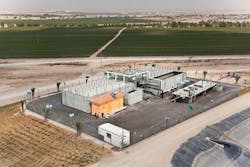HDPE Pipe Selected for Florida Transmission Main
The Yankee Lake project in Seminole County, FL, is one of the first to use the St. Johns River as an alternative water supply to meet the future drinking water needs of its customers. To accomplish this, Seminole County installed two new 42" high density polyethylene (HDPE) transmission pipelines to draw water from the St. Johns River to the new Yankee Lake Water Treatment Facility.
To date, most of Florida has relied on groundwater because of the impeccable quality, abundance and the lack of expense to treat the water. Unfortunately, this approach has led to an over-reliance on just one source – the Florida aquifer. This dependency has now put the aquifer, springs, lakes and the environment at risk.
To manage that risk, the St. Johns River Water Management District of northeast and east-central Florida has mandated the diversification of water resources. Starting in 2013, new or increased groundwater withdrawals will not be permitted in Central Florida and water users will be required to develop alternative water supply sources to meet their needs.
The Yankee Lake project in Seminole County, FL, is one of the first to use the St. Johns River as an alternative water supply to meet the future drinking water needs of its customers. To accomplish this, Seminole County installed two new 42” high density polyethylene (HDPE) transmission pipelines to draw water from the St. Johns River to the new Yankee Lake Water Treatment Facility.
Engineering firm in charge of the project was CH2M Hill. General Contractor was Encore Construction.
Performance Pipe’s PE4710 HDPE pipe was selected for the project based on its flexibility, resistance to corrosion, and 50-100 year design life. Over 40,000 feet of the pipe was heat fused and installed using open-cut, direct burial construction. It is the largest HDPE water transmission pipe project in the United States.
Installation of the pipeline began in early 2010 and was completed earlier this year. The entire raw water pipeline has been successfully pressure tested.
The pipe was fused using a mobile McElroy fusing machine with a separate generator. A computerized datalogger was used to record each joint’s heating time and temperature, fusing time and temperature and cooling down period.
The 53-foot sections of HDPE pipe weighed approximately 5500 lbs. Each fused joint was provided with a unique embedded joint number and the contractor included this information on surveyed as-builts. The owner will be able to identify exactly where each joint is located in the future if needed. There are over 800 fused joints in the completed pipeline.
An average of approximately 500 linear feet of pipe was fused each day. Depth of bury varied from six to eight feet below ground.
A large portion of the pipe was installed through environmentally sensitive areas such as wetlands, protected species habitats and preserves. Contractors and construction management staff successfully met conditions of a detailed Environmental Resource Permit, including strict restrictions on turbidity discharge, seasonal work restriction on scrub jay habitat area, and restoration of wetland areas.
The raw water pipeline portion of the project included over 10 miles of turbidity barrier and silt fencing. Part of the project included providing training materials (i.e. documents, videos, etc.) for work crews to inform them of environmentally sensitive issues related to the pipeline installation.
The Yankee Lake project is a clear advancement in plastic pipe, particularly in promoting the new high performance PE4710 resin material. The new HDPE material used for this project has increased density, higher tensile strength, and higher resistance to slow crack growth. Because of these increased properties, the Yankee Lake design allows higher service pressure or reduced wall thickness, increased hydraulic capacity and better overall mechanical properties than the former PE3408 HDPE pipe material.
The Yankee Lake project is one of the most important projects in Central Florida because it is a crucial part of the St. Johns River Water Management District’s long-term water supply plan to reduce groundwater use and increase drinking water alternatives.
The new pipelines installed in Phase I of this project will provide up to 5.5 million gallons of water per day for reclaim water augmentation. The treated water will be conveyed to the adjacent reuse facility, where it will be blended with the reuse stream prior to distribution for irrigation (public access reuse). Phase II of the project, which is 6 to 10 years away, will involve withdrawing 4.5 mgd from the river for drinking water.
These river withdrawals will have no measurable impact on the river however it will provide needed water supplies and reduce the use of groundwater. By using this alternative water source, Seminole County is protecting precious groundwater supplies, the Wekiva Springs and the environment.
WW
More WaterWorld Current Issue Articles
More WaterWorld Archives Issue Articles


